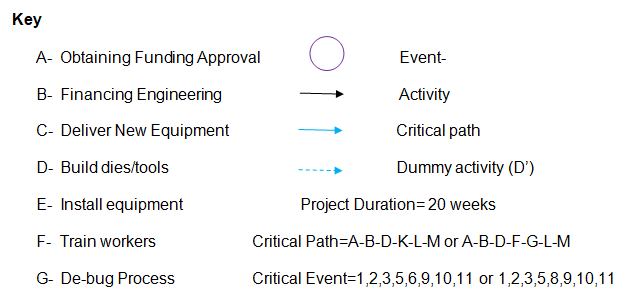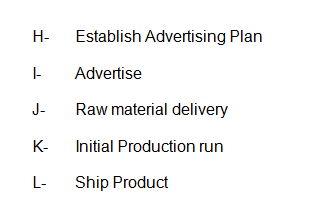Drawing Network
Gadget Toy Company’s Network



Purpose of Critical Path
A critical path helps the management to identify the most crucial activity in every project. A critical path is the longest time that a project can take to be completed. At the same time, it is the shortest time that a project can take because it has no float time.
Identification of the critical path helps the management in allocating resources and directing the activities in order to accomplish the project within the stipulated time schedule (Webb, 2002). The critical path shows activities whose duration can be reduced to reduce the overall production duration.
Otherwise, reducing activities, which do not form part of the critical path, increases cost without reducing the overall project duration. The critical path outlines the most important sets of activities which when implemented the project goals will be realized (Webb, 2002).
Tracking the project using the Critical path
Critical path analysis allows management to monitor the development of the project while tracing its achievement (Webb, 2002). Through the critical path, the management can tell whether they will be able to meet their targeted goals or not. Any deviation arising are easily detected and remedial action are employed promptly to address any shortcomings.
Moreover, the critical path helps the management to identify activities, which can be delayed in order to allocate limited resources to other activities without affecting the project duration. On the same note, the critical path helps the management make good judgments pertaining future changes in costs and other eventualities.
To hasten project analysis, Critical path is used to develop Gantt Charts, which illustrates the sequence in which activities are implemented (Webb, 2002). Gantt charts also shows which activities should be completed first before initiating others, without the critical path the management may find it difficult to understand which activities to implement first.
Ways Preventing Project delays
To keep the project on track the management may decide to switch some resource from an activity with float time to a critical activity. This process helps to ensure that all the critical activities are ran smoothly while delaying other activities, which are not critical (Webb, 2002).
Delaying such projects does not affect the overall project duration. From the network drawn above, the management of Gadget Company may opt to delay activity D (Deliver material) to allocate more time for installing tools (activity E).
Secondly, the management may opt to hire additional labor, or provide for overtime (work on weekends) in order to reinstate the project back on track. However such as measure means requires additional allocation of money to hire more labor.
The other way that a project can be kept on track is by working at night so as to make up for the lost time. The other alternative would involve increasing supply so as to hasten the rate project completion time. However, any decision to increase labor and supply means incurring extra cost, which may not be readily available.
Finally, Gadget Toy may opt to crash one of the critical activities to reduce the operation time. Crashing an activity involves reducing the duration taken by an activity at a higher cost. Crashing cost depends on the time reduced on top of the original cost budgeted for that activity.
Ways of linking interrelated projects
There are several ways of linking multiple projects with interdependencies using the critical path method namely:
- Performance Evaluation and Review Technique (PERT),
- Earned Value Management (EVM)
- Graphical Evaluation and Review Technique (GERT)
Program Evaluation and Review technique
According to Webb (2002) PERT forms the foundation of planning and forecasting thereby enabling the management to prepare in advance. Apart from this, PERT provide management with ample time when it comes to decisions making especially in interrelated projects and portfolio projects.
This management tool not only helps in effective utilization of resources of resource but it also ensures that all projects are completed within the stipulated time. This is made possible by visibility provided by the project as single process is used for various projects. Finally, PERT is a reliable tool for handling uncertainties because all projects are laid in a horizontal manner that makes it easier for management to detect any delay or slack.
Earned Value Management (EVM)
EVM is another popular method of linking project that is being used in the modern management practices. It involves analyzing various projects, portfolios and businesses, it provide management with information tools to handle several projects at ago.
In addition, EVM provides insight for future changes in project implementation. In order for management to adequately prepare for the impending uncertainties, EVM provides room for prioritizing some projects while delaying others in order to facility a mutual relationship between them.
Graphical Evaluation and Review Technique (GERT)
GERT operates in a similar way as the Pert but have some differences because it allow looping, project branching and multiple projects handling. GERT is an improvement on PERT because it elaborates the status of a project whether it is successful or not. Incase a project branch fails to deliver the expected results the management switches attention to other branch.
Benefits of Linking Projects
Linking project has become a popular method of handling various projects that are interrelated, through linking such project the management derives many benefits.
Firstly, the management improves planning as linkages facilitate projecting the future trends of the projects in terms of time and money requirement. With such a foresight the management plans in advance on how to overcome such challenges by delaying some projects or by increasing labor to meet the stipulated deadline.
Pennypacker and Dye (1999) asserts that connecting several interrelated projects provides room for identifying repetitive activities. This helps in streamlining operation since the criteria for handling this project remains similar from one set of activities to the other. Repeated action promotes managers dexterity and confidence in handling similar projects in future thereby improving their efficiency.
Integrating projects helps the managers to reschedule activities to display project interdependencies and how such relationships stretch the available resources. However, with this challenge in the mind the manager ensures proper prioritization of activities for efficiency utilization of limited resources.
With the modern state-of-the- art, linking projects has also provided room for development of software to handles multi-projects in one go. Such development has acted to the best interest of managers whose role has been reduced to monitoring the progress and checking for compliance with the set time limits.
Additionally, the management has the challenge of dealing with conflicts between projects and ensuring optimal allocation of resource between such projects. Moreover, the managers have the obligation of allocating resources according to the priorities set for the conflicting projects.
Nevertheless, setting priority for activities forming part of the critical path has proved to be cumbersome and as a result, the management should always remain vigilant at such critical moments (Pennypacker and Dye, 1999).
Reference List
Pennypacker, S.J. & Dye, D. L. (1999). Project Portfolio Management, Selecting and Prioritizing Projects for Competitive Advantage. West Chester: Centre for Business Practices.
Webb, A. (2002). Project Management for Successful Product Innovation. Hampshire: Gower Publisher